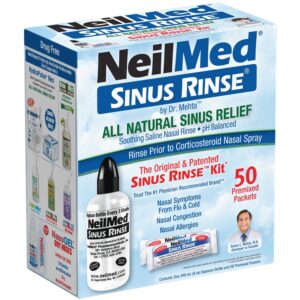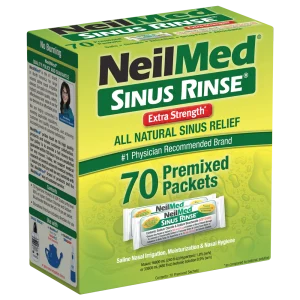Hypertonic Or Isotonic?
DIFFERENCE BETWEEN ISOTONIC & HYPERTONIC PACKETS
Isotonic Saline is defined as 9 mg of sodium chloride per mL of water. Any concentration higher than this is defined as hypertonic. Limited research shows that a hypertonic saline solution may be more effective in reducing nasal mucosal or nasal lining congestion on a short term basis of a few hours. The theory is that hypertonic salt solution will draw water component out of the congested nasal tissue. It is possible that you may experience temporary burning or stinging with the hypertonic solution. If you experience any burning or discomfort, please use an isotonic solution. For your convenience, one NeilMed® blue packet in 240 mL of water is isotonic and one green packet in 240 mL is hypertonic.

ARTICLES ON ISOTONIC VS HYPERTONIC

Shoseyov D, Bibi H, Shai P, Shoseyov N, Shazberg G, Hurvitz H.
Source
Pediatric Department, Bikur Cholim Hospital, Hadassa Medical School, Jerusalem, Israel.
Abstract
BACKGROUND:
Chronic sinusitis (CS) is a common disease in children, especially those with allergies, that is caused by impaired drainage from the sinuses. Hypertonic NaCl solution has been shown to increase mucociliary clearance and ciliary beat frequency.
OBJECTIVE:
We performed a randomized double blind study to compare the effect of nasal wash with hypertonic saline (HS) (3.5%) versus normalsaline (NS) (0.9%) on CS.
METHODS:
Thirty patients with CS aged 3 to 16 years were studied. They were randomly divided into two treatment groups matched by age and severity of the disease. Each individual was treated with either HS or NS for 4 weeks. All patients were evaluated by two clinical scores (cough andnasal secretions/postnasal drip [PND]) and by a radiology score at the beginning of the study and after 4 weeks.
RESULTS:
The HS group improved significantly in all scores (average +/- SD): cough score, from 3.6 +/- 0.51 to 1.6 +/- 0.74; nasal secretion/PND score, from 2.86 +/- 0.35 to 1.6 +/- 0.74; and radiology score, from 8.06 +/- 1.28 to 2.66 +/- 1.04. The NS treatment group showed significant improvement only in the PND score (from 2.66 +/- 0.49 to 1.53 +/- 0.83) but no significant change in both the cough score (from 3.53 +/- 0.52 to 3.33 +/- 0.49) and the radiology score (from 8.13 +/- 1.25 to 7.86 +/- 0.91). Clinical observation 1 month after the end of the study showed no change compared with the end of the study in both groups. CONCLUSION:
HS nasal wash is an efficient treatment of CS.
External Links
https://www.ncbi.nlm.nih.gov/pubmed/9600495
Kim CH, Hyun Song M, Eun Ahn Y, Lee JG, Yoon JH.
Source
Department of Otorhinolaryngology, Yonsei University College of Medicine, Seoul, South Korea.
Abstract
CONCLUSION:
We speculate that isotonic saline is the most physiological irrigation solution in terms of mucus secretion and the cellular morphology of nasal epithelial cells.
OBJECTIVE:
To determine the most physiologic and effective saline concentration for nasal irrigation in terms of mucus secretion and cellular morphology by using normal human nasal epithelial cells treated with hypo-, iso- and hypertonic saline.
MATERIAL AND METHODS:
Fully differentiated passage-2 normal human nasal epithelial cells were treated with pure water and with 0.3% (hypotonic), 0.9% (isotonic) and 3% (hypertonic) saline solutions. mRNA expression levels of MUC5AC and MUC5B, which are known to be major airway mucins, were analyzed after 30 min using reverse transcriptase polymerase chain reaction. Total mucin and MUC5AC and MUC5B mucin secretions were analyzed using dot-blotting. Cellular morphology was observed with light microscopy after hematoxylin-eosin staining and with scanning electron microscopy.
RESULTS:
MUC5AC and MUC5B mRNA levels did not change after treatment with pure water and various concentrations of saline. Total mucin and MUC5AC mucin secretions only increased following pure water treatment, while MUC5B mucin secretion increased with pure water, hypo- and hypertonic saline treatment. Morphologic analysis revealed that pure water severely damaged normal human nasal epithelial cells and that only isotonic saline did not affect their morphology.
External Links
https://www.ncbi.nlm.nih.gov/pubmed/16303677
Ural A, Oktemer TK, Kizil Y, Ileri F, Uslu S.
Source
Department of Otorhinolaryngology, School of Medicine, Gazi University, Ankara, Turkey. ahmetural2001@yahoo.com
Abstract
OBJECTIVE:
To investigate the impact of nasal irrigation with isotonic or hypertonic sodium chloride solution on mucociliary clearance time in patients with allergic rhinitis, acute sinusitis and chronic sinusitis.
PATIENTS AND METHODS:
Mucociliary clearance time was measured using the saccharine clearance test on 132 adults before and after 10 days' application of intranasal isotonic or hypertonic saline. Patient numbers were as follows: controls, 45; allergic rhinitis, 21; acute sinusitis, 24; and chronic sinusitis, 42. The results before and after irrigation were compared using the Wilcoxon t-test.
RESULTS:
Before application of saline solutions, mucociliary clearance times in the three patient treatment groups were found to be significantly delayed, compared with the control group. Irrigation with hypertonic saline restored impaired mucociliary clearance in chronic sinusitis patients (p < 0.05), while isotonic saline improved mucociliary clearance times significantly in allergic rhinitis and acute sinusitis patients (p < 0.05).
CONCLUSION:
Nasal irrigation with isotonic or hypertonic saline can improve mucociliary clearance time in various nasal pathologies. However, these solutions should be selectively prescribed rather than used based on anecdotal evidence. Further studies should be conducted to develop a protocol for standardised use of saline solution irrigation in various nasal pathologies.
External Links
https://www.ncbi.nlm.nih.gov/pubmed/18957157
Michel O, Dressler AK.
Source
Vrije Universiteit Brussel, Universitair Ziekenhuis Dienst KNO, Brüssel, Belgium. omichel@uzbrussel.be
Abstract
PURPOSE:
In several in-vitro research studies was shown that hypertonic salt water solution has an enhancing effect on mucociliary beat frequency. Nevertheless nose sprays with isotonic salt water solution are more popular on the market. They are sold as wellness products but also for care and cure of various nose diseases.
METHODS:
In a randomized double-blind trial with n = 20 healthy volunteers the effect of a 7-day application of hypertonic sodium chloride solution (3% NaCl) measured by saccharine-clearance-test (SCT), rhinomanometry and questionnaires was evaluated in comparison to a isotonic salt solution (0,9% NaCl).
RESULTS:
The SCT showed in both groups no significant change. In rhinomanometry a significant higher rate of airflow could be measured after a 7 day period of applicating hypertonic spray. The volunteers evaluated the hypertonic solution as "more effective" in regard their nasal airflow.
CONCLUSION:
Although in this RCT an effect on mucociliary clearance could not be detected after a 7 day application of salt water nose spray, ahypertonic spray showed objectively and subjectively a significant influence on nasal airflow. This effect could be of interest eg. in reducing the use of decongestive nose sprays.
External Links
https://www.ncbi.nlm.nih.gov/pubmed/21308609
Get That Clean Nose Feeling®
Join our mailing list to stay up to date the the latest information on special offers, promotions, medical literatures, and publications.
